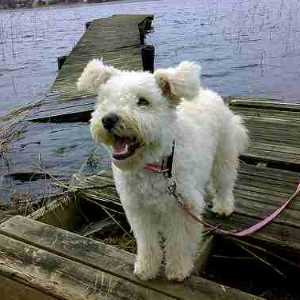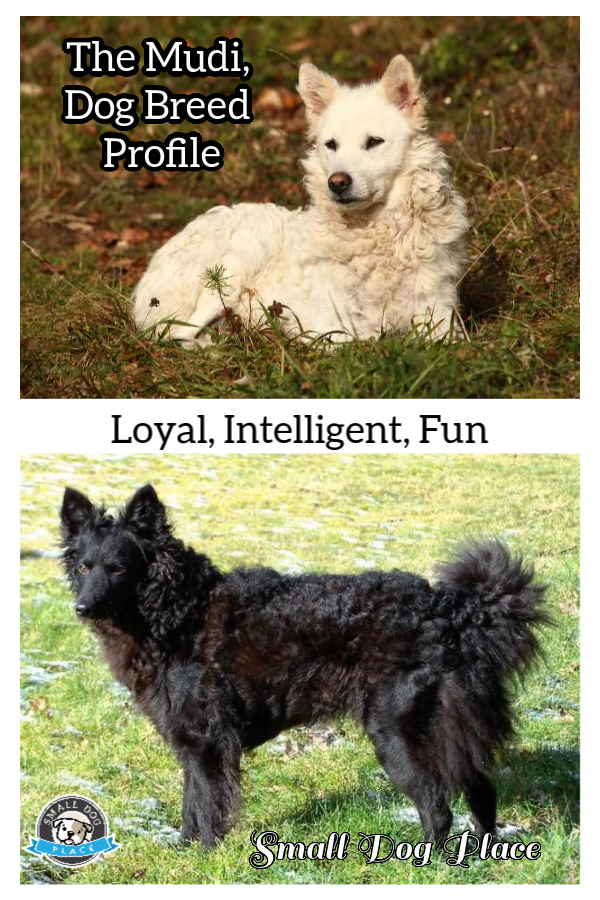Mudi Dog Breed Information
by Janice Jones
If you don’t live in Hungry or Finland, you may have never encountered a Mudi (pronounced “moodie”) or Mudik (plural form) but even in these countries, this breed is rare.
They’ve been in existence since the 19th century and have a little Puli, Pumi, and German Spitz in its genes making them an active, intelligent farm dog. But if you love agility, obedience or flyball, this might be just the breed for you. He’s a hard worker and is known for his ability to herd both cattle and sheep. They’ve even been used as search and rescue dogs.
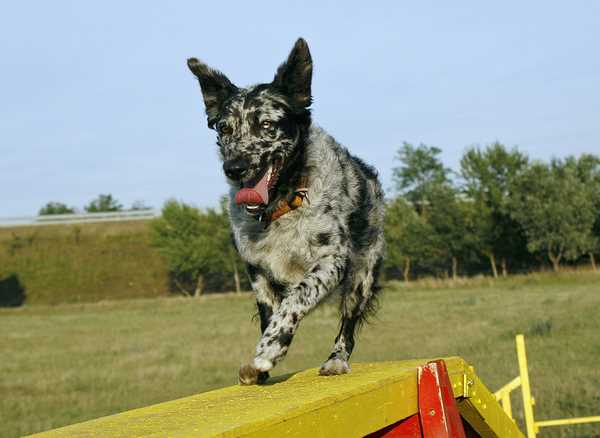
Typically considered a medium-sized dog, we’ve included them here because some members of the breed can be as small as 18 pounds. As a member of the Miscellaneous class of the AKC, their standard states that they can be from 18 to 29 pounds and up to 18.5 inches.
Quick Facts About the Mudi
Other Names Used: Hungarian Mudi, Canis Ovilis Fenyesi
Affiliation: AKC Miscellaneous Class FCI Hearding, CKC Miscellaneous Hearding Group 7, UKC Heading
Size
Height: 14 - 20 inches (38 - 47 cm)
Weight: 18 - 29 pounds (8 - 13 kg)
Coat Type: short hair on the head and front of the legs, and wavy-to-curly hair over the rest of the body, light-to-average shedder.
Colors: Black, Brown, Gray, Gray Brown, White, Yellow with Merle Markings
Country of Origin: Hungary
Activity Level: Active
Life Expectancy: 12-14 years
Good with Children: Yes, especially when raised with them
Good with Other Pets: yes
Average Litter Size: 5-10 puppies
Average Puppy Cost: approximately $1500 USD for pet quality
History
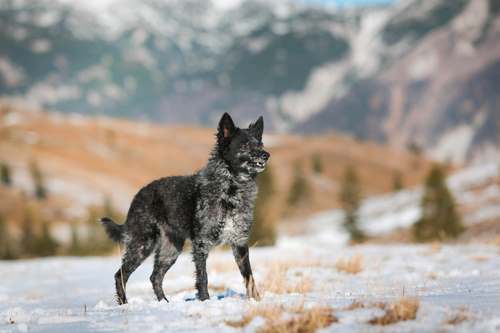
The Magyars, the original name of Hungarians, kept sheepdogs from the end of the ninth century, but there were no specific breeding programs or classification of dogs until about the second half of the 19th century.
Before Hungarian sheepdogs were merely divided into two categories: large and small. When breeding, the smaller dogs were separated from the bigger dogs (i.e., Kuvasz, Komondor). The three smaller ones, Puli, Pumi, and Mudi, were allowed to mate.
So, it is difficult to differentiate the early histories of these three breeds, and this continued into the 20th century.
Many breeds originating in the 19th century can be traced back to a deliberate effort to combine several breeds to create a new one that had a unique look, ability, or desired personality trait. Often these new breeds were created by just a handful of people or one specific farmer in need of any particular type of dog.
This doesn’t seem to be the case with the Mudi. Instead, they seem to have come into existence naturally through the matings of the German Spitz dog, Puli, and Pumi. Before 1936, the Mudi, Puli, and Pumi were not considered different breeds.
Dr. Dezso Fenyes, a breeder and museum director is credited with discovering the breed in 1936. From then on, the Mudi became a specific breed. Unfortunately, World War II intervened, and almost all Mudi went extinct, being killed during the war. After the ward, they did make a comeback, but they are still scarce.
The FCI recognized the breed in 1966 and the UKC followed in 2006. In 2004, the breed was admitted into the AKC’s foundation stock service, but has not yet received full breed recognition from the AKC.
Personality/Temperament
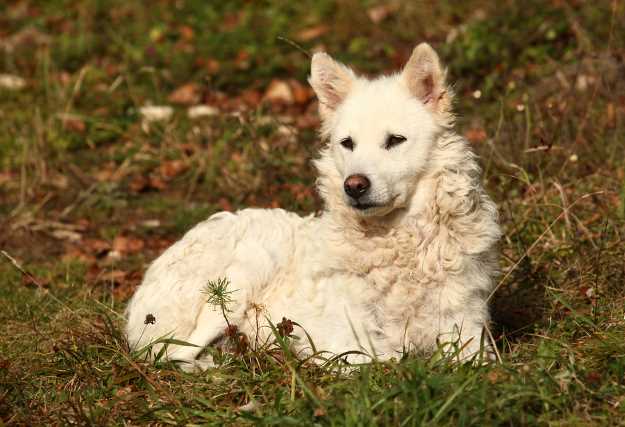
Every dog is unique regardless of its membership within a breed and the Mudi is no exception. With that said, you can identify some traits that are more likely to show up in a specific breed. Mudi can be very affectionate, clingy, or want to be by your side at all times. Others are more independent and are fine to be near you as long as you are within eyesight.
Mudi can be wary of strangers and may even bark or growl if a new person approaches. Much of this can be resolved through early training and socialization. With enough socialization, meeting new people will become easier. They will be less shy or scared, but not likely to be ecstatic when a new person enters their environment. This reserve is a trait shared by many other herding dogs.
They do bond strongly with their person and tend to be extremely loyal and want to please. They don’t enjoy long periods without the presence of their human and have been known to find ways to keep busy when there’s nothing else to do. These activities can involve digging, chewing, and barking.
They are intelligent and can work independently, traits that are needed for keeping flocks supervised and safe. They are friendly and playful around family members.
The Mudi does fine with children and other animals, especially when they’ve been raised since puppy-hood and generally act easy going and affectionate with children they consider to be their own.
Coat & Grooming
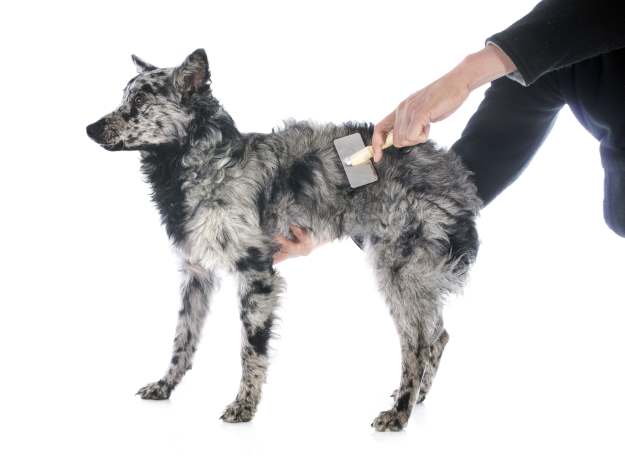
This is an easy dog to maintain and requires little in the way of grooming.
They have a very dense, wavy to curly coat which grows to about one to three inches long. Sometimes the hair on the underside may be a little longer and up to 5 inches. Luckily, the texture of the Mudi coat makes them unlikely to mat. If shown in confirmation, Mudi’s coat is natural so it will appear naturally curly.
The Mudi is a seasonal shedder, usually shedding in the spring and then regrowing its full coat in the autumn. A brush or comb periodically to remove dead hair and the occasional bath will keep your Mudi looking fine. He will need his nails clipped if they are not worn down naturally and dental cleaning to keep those pearly whites sparkling for a long time.
Usually, the coat of a Mudi is not cut or clipped but kept at the natural length. After bathing, use a towel to dry off or if you prefer to use a hairdryer and pin brush for a softer straighter look.
Health Concerns of the Mudi
This is a relatively healthy breed and to assure a healthy puppy, chose a breeder that does those health screenings recommended by the AKC parent club and the OFA which include screenings for Hip and Elbow Dysplasia, Eye examinations and Patellar Luxation. Other optional screenings available for this breed include Autoimine thyroiditis, multiple drug sensitivity, and cardiac evaluation. They generally live 12 to 14 years.
Conditions that have been reported for this breed include
- Hip dysplasia
- Congenital Cataracts
- Epilepsy
- Color dilution alopecia (“blue dog syndrome”),
Feeding and Diet
The Mudi is an active dog so you will need to choose a small to medium size dog food formula for active dogs. Use a puppy formula until about one year old and then switch to the adult formula.
You will want to incorporate treats into your training program but take the calories from treats into consideration when planning out the daily caloric intake. Fruits and Vegetables are also a good source for healthy snacks but don’t overdo them daily.
Since there are many different types of dog food, you will want to choose the best option for your lifestyle and your dog’s health. If unsure, consult your dog’s breeder or veterinarian for the best options.
Lifestyle
Best Suited For
This breed is not for everyone and in fact, if you live outside of Hungry or other places in Europe, you may wait a long time to get your Mudi puppy. They are not well suited for apartments due to their vocal natures, somewhat suspicious character, and their need for exercise.
They require that owners be active themselves and willing to take the time to train and exercise the dog. They don’t do well left alone outside but should be part of the family and the activities that the family enjoys.
It is possible to train dogs to be “quiet” on command and if that is the case, apartment living might be an option. Remember though that they will need daily walks and a park to run. Agility training is also an excellent outlet for some of that energy as well as flyball.
They are good with children, primarily if raised with them, and will do OK with other dogs if raised together.
Mudik are not likely to be the best choice for beginner dog owners. They need training, socialization, and an owner who will be positive, but firm and will have the energy to keep up with the activity needs of the dog.
Exercise and Activity Level
Mudik are active dogs and will require plenty of exercise. They love to run and the ideal home will have a decent sized fenced yard for them to enjoy what they like best.
A good jog, run or long walk will also tire them out. Inside the home, they are calm. If you do have a fence, you will still want to supervise your Mudi as he likes to dig as well as jump, so the fence will need to be tall enough to prevent escape as well as secure sufficient that digging won’t create a path to freedom.
Training
Mudik are very easy to train. However, it is best to use positive reinforcement methods and make the training fun and challenging. They appreciate a good run and will need plenty of exercise so if you plan on doing obedience training, I would recommend you allow them to get some exercise before settling down for a serious training session.
The characteristics that make them a great working dog also make them easy to train. They are enthusiastic learners, but also vocal and highly energetic. They are eager to please but somewhat suspicious of strangers, which also makes them a good watchdog.
Pros of Living with A Mudi
- Smart
- Healthy
- Little Grooming
- Great watchdog
- Loyal and affectionate
- Good with Children
Cons:
- Very vocal and will bark at nearly anything (this is part of their heritage of being a herding breed – they must alert the flock guardian to trouble ahead. They sound the alarm and the guardians, Kuvasz and Komondors, jump into action.
- Prone to dig and jump
- Independent
- May be stubborn or shy
- Some are aggressive towards other dogs.
What are the Differences between Puli, Pumi and Mudi?
These are similar breeds but there are some differences
Appearance-wise, the Mudi has oval eyes, while the Puli has almond shaped eyes and Pumi have more roundish eyes.
Mudi’s ears are pricked and stand up like a Spitz. Pumi’s ears are carried 2/3 erect with the tips pointing down and to the side; Puli ears are hanging.
Puli has a corded coat and can continue to grow to the ground. Mudi has a half long curl, wavy coat and the Pumi's coat is similar
Mudi can be born without a tail Pumi has a full tail that is set high and held over the body. Puli’s tail is carried over the top of the body
Pumi is 27-29 pounds (male), 22-24 pounds
Puli is 25-35 pounds
Mudi is 18-29 pounds
Check out these other breeds.
References Used in this Breed Profile
Share Your Experience Living with a Mudi
I love to receive comments and feedback from my site’s visitors—everything helps make this site even better. Why not join in and share your thoughts about what you just read.
Come back soon,
Janice
About Janice (author and voice behind this site)
Having lived with dogs and cats most of her life, Janice served as a veterinary technician for ten years in Maryland and twelve years as a Shih Tzu dog breeder in Ohio.
Her education includes undergraduate degrees in Psychology with a minor in biology, Early Childhood Education, and Nursing, and a master's in Mental Health Counseling.
She is a lifelong learner, a dog lover, and passionate about the welfare of animals. Her favorite breed for over 50 years has been the Shih Tzu, but she has also lived with Poodles, Maltese, Yorkshire Terriers, Beagles, English Bulldogs, Carin Terriers, and a Cocker Spaniel.
When not writing, reading, and researching dog-related topics, she likes to spend time with her eight Shih Tzu dogs, husband, and family, as well as knitting and crocheting. She is also the voice behind Miracle Shih Tzu and Smart-Knit-Crocheting
Does This Article Deserve Your Thumbs Up?
We always appreciate your support and encouragement. Your thumbs up means so much to us. Please like this article.
If you find this page or any page on Small Dog Place Helpful, or useful in anyway, I'd love it if you would click the small heart found on the bottom right of each page.
You can also share or bookmark this page -- just click on the:

Free Monthly Newsletter
Sign Up for Our Free Newsletter and get our Free Gift to You.
my E-book, The Top 10 Mistakes People Make When Choosing a Dog (and how to avoid them)
